For the fresh water aquarists the Zebra Danio has been a long time favorite for them may for the fact that it can easily be reared in groups in the same tank. It gets the Zebra name owing to its characteristic bright blue or purple lines that run parallel from the head to the tail on its body.
Table of Contents
Zebra Danio Overview
Zebra danios are available to buy across the US. GloFish danios, a genetically altered color mutation of zebra danios, are more popular and readily available than conventional zebra danios.
It is also scientifically referred to as the Brachydanio Rerio, the other names include; zebrafish, striped danio, and zebra fish. It is relatively peaceful and will live harmoniously with other peaceful fish species that are of body sizes similar to it. It is a schooling fish that has a small body which usually reaches a maximum of 2 and quarter inches. It is actually one of the first tropical fish varieties that were kept in aquariums and it has remained a favorite of select hobbyists and aquarium enthusiasts alike.
The fish is affordable and thus a perfect choice for beginners and even advanced aquarists. They are hardy and will easily adjust to varied types of habitats without much of a hustle. The females are excellent layers and will lay so many eggs and if you are in the hunt for perfect layers, the Zebra Danio will perfect for you.
| Information Chart | Zebra Danio |
| Scientific Name: | Danio rerio |
| Family: | quintessential community fish |
| Care Level: | Easy |
| Temperament: | Peaceful, playful |
| Color: | Blue, green, red, purple, orange, and other hues; black and white stripes |
| Lifespan: | 3–5 years |
| Size: | 1.5–2.5 inches |
| Diet: | Omnivore |
| Minimum Tank Size: | 10 gallons |
| Temperature: | 64–77°F (18–25°C) |
| Water
Conditions: |
82°F in the summer, 60°F in the winter |
| Tank Mate Compatibility | Easy |
Zebra Danio Appearance
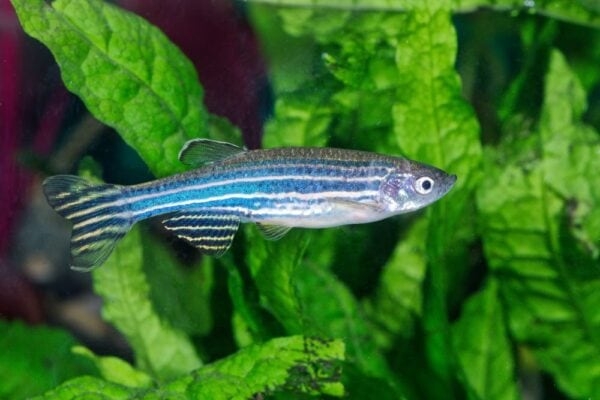
The fish are so easy to recognize due to their characteristic and attractive zebra like appearance. They have black and white stripes patterns that adorn their bodies in such an attractive manner making it a favorite for display aquariums.
As for the body size, the zebra danio has got a slender but compressed body with a barbel at every end of their lips. The fish have small bodies with the maximum body size reaching just 7cm in length (2 and a quarter inches) while in the aquarium. They can grow slightly larger if they are left in the pond or in their natural habitats.
With just one glance at this fish, it’s clear why it was named after the legendary mammal. The horizontal stripes that run from the gill plate to the tail are the most distinguishing characteristic of this species.
The stripes are usually a bluish-purple tint in appearance. In other cases, they may even seem black or gray, depending on the lighting circumstances. Slivers of silver-gold are used to balance off the black stripes.
This fish species has a characteristic body color of pale yellow that is characterized with about five steel-blue stripes that run horizontally on the body. The steel-blue stripes fade towards the fins but effectively extend to the fish’s tail fin.
Varieties of Zebra Danio
The typical zebra danio has short, rounded fins and a rounded tail. The longfin zebra danio is a captive-bred aquarium fish with long, flowing fins and a long tail, nearly three times the length of the ordinary zebra danio’s fins and tail.
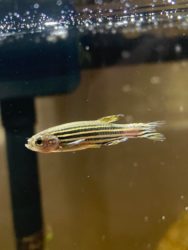
In the aquarium industry, zebra danios are found in various colors, including silvery-green, pink, blue, and purple bodies. All zebra danios have white stripes with black borders and different color strips, such as blue.
Neon varieties of the zebra danio, termed GloFish danios, are also available in several colors: Sunburst Orange, Galactic Purple, Starfire Red, Electric Green, and Cosmic Blue.
Albino zebra danios have white-gold bodies and red eyes. These fish are uncommon in the wild because their colors make them easy prey, but they’re pretty popular in the fish trade.
Stressed zebra danios lose their color. Male and female zebra danios have brighter, bolder stripes when striving to impress their lovers during the mating season.
The Lifespan Of Zebra Danio
The life expectancy of a zebra danio varies between two and five years, depending on the species.
There are no guarantees when it comes to life expectancy. The life expectancy of a Zebra Danio is identical to that of any other pet and is primarily governed by the kind of care you give.
Those who live in spotless surroundings and consume a high-quality meal are more likely to accomplish the five-year milestone than the general population.
On the other hand, fish in inadequately managed tanks are more likely to suffer disease and die early.
Zebra Danio Size
This species is relatively small compared to other commonly seen freshwater tank fish! Zebra danios may grow up to 2.5 inches in length when fully matured. Both men and females have similar height and weight; however, females are much broader in the belly area than males.
Natural Habitat And Origin
This fish species are originally native to the Asian continent and they countries they are said to have originated from in Asia being; Pakistan, India and even Myanmar. In India, they are said to occur naturally in the Kosi River in Uttar Pradesh. There are also some few numbers of the fish in Nepal, Bangladesh and Bhutan.
Zebra danios are endemic to tropical and subtropical rivers in India, Bhutan, and Bangladesh, where they swim in schools. The natural environment of the zebra danio changes depending on the season.
It is a fresh water fish species that is known to inhabit the lower reaches of streams, rivers, ponds and even ditches. The fish keeps changing its habitat as per the seasons and times of the year. There are times you will find adult Zebra Danio occupying seasonal pools or rice paddies especially during the wet season. During this time they easily spawn and feed extensively so that their numbers greatly multiply. In fact, the zebra danio are said to be so invasive so that their numbers are considered safe. The fish prefers living in natural habitats that is heavily vegetated and silty with still waters that are not violent.
Zebra Danio Care & Tank Set-Up
The fish are a schooling fish species that will easily adapt to a variety of water conditions they are not used to in the wild. While in the aquarium, they like to spend much of their time either in the top or middle parts of the aquarium. Even though most waters that the Zebra Danio inhabit in the wild are generally acidic in nature, the current stock available for hobbyists have been kept in fairly acidic waters. This therefore requires you to be more mindful of the pH of the tank and not let it to be too acidic.
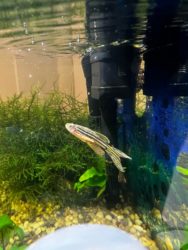
Let us have a quick glance at the basic tank requirements for the fish:
- The minimum tank size should be able to hold at least 20 gallons of water. This translates to about 76 liters of water in the tank.
- Ensure that the water in the tank is fresh water with less acidity.
- Ensure that the tank water is well maintained and the cleanliness is maintained at all times. Remember that aquariums are closed systems and therefore need to be well taken care of to ensure better health of the fish.
- Also ensure that the tank has a lid to keep it covered to prevent the fish from jumping out of it.
- Also ensure that you provide good filtration in the tank so the water is kept in excellent condition.
- It is best to replace the water in the tank at least once every month depending on the population of the tank. It is however recommended to replace water in a densely populated tank each week.
- The pH range should be kept at 6.0 to 8.0.
- The water movement should be weak.
- Lighting in the tank should be moderate.
- The tank temperature should be 6.0 to 75°F.
- The hardness of the water should be 2-20 dGH.
Taking care of zebra danios is straightforward since they eat practically everything you give them. Recreate the danio’s natural environment in captivity and give them an omnivorous diet to ensure that they are happy and healthy in their new environment.
Zebra Danio Tank Size And Specifications
Although Zebra Danios prefer to stay in water bodies with a fair bit of current to assist them in surviving, these small fishes do not require multiple settings to live, which is a pleasant relief. Of course, more is typically better in this scenario.
The fact that Zebra Danios are small enables them to flourish in aquariums as little as 5 gallons; nevertheless, as they are social fish and maybe hyperactive at times, they are best suited to more extensive, busier aquariums.
Optimum Tank Size For Zebra Danio
The optimal tank size for Zebra Danios is anything more significant than 10 gallons in capacity.
Filter Type
Zebra Danios aren’t picky when filtering their surroundings. You may use any filter you want, but we suggest using a HOB filter because of the additional current they can offer for the zebra danios to play in. You can use any filter you want, but we recommend using a HOB filter.
Substrate
Start by putting a layer of tank substrate. You may use fine sand or gravel.
Zebra Danios don’t spend much time towards the bottom, and they may travel down there every once in a while, but they’re not prone to substrate-related ailments like other fish.
How many Zebra Danio in a 10-gallon tank
5
Water Parameters For Zebra Danio
Water Temperature
64°F to 82°F (Around 76 degrees is ideal)
pH Level
6.5 to 7.5 (Keep the pH as neutral as possible)
Zebra Danio Tank Landscape
Best Plants for Zebra Danio Tanks
Plants like Java fern and Amazon sword assist with oxygen circulation in a zebra danio tank. Zebra danios enjoy exploring and hiding in plants, and the variety of habitat supplied by plants may minimize territorial behavior.
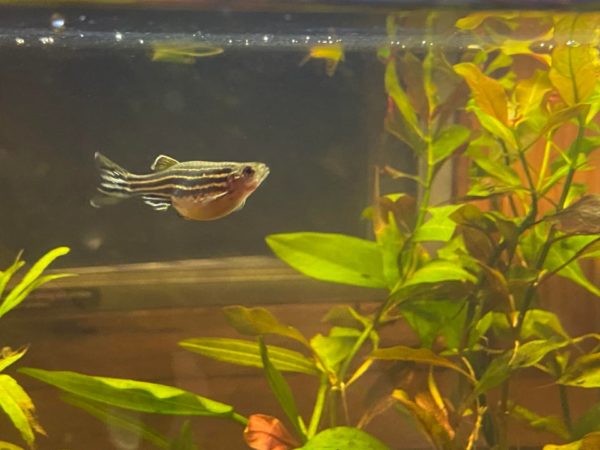
Decorations For Zebra Danio Tanks
You can decorate the bottom of the tank with fragments of bogwood and rounded stones to replicate the rocks and roots prevalent in the zebra danio’s natural environment.
Lighting for Zebra Danio Tanks
Standard aquarium lighting is required for plant development and to simulate the day-to-night cycle in the aquarium. For the fish’s neon colors to be shown, GloFish zebra danios need blue light.
Feeding
The fish are omnivorous and will feed on small insects, worms, small crustaceans and larvae like mosquito larvae in their wild habitat. When keeping the fish in the aquarium ensure that you feed them on the above named foods but maintain the aquarium cleanliness. Remove food substrates that the fish have fed on and left as these may serve a source for infection for the fish.
Feeding them several times a day will do them justice as they are excellent feeders who will stop at nothing until they get full. Just ensure that you feed them for at least three minutes each session. You can as well offer them fish flake food or even pellet/tablets.
In the wild, zebra danios consume various foods, including algae, worms, crustaceans, and mosquito larvae, among other things. To guarantee that the fish get all of the required critical elements from their food in captivity, feed them a diet identical to their wild counterpart.
Best Diet For Zebra Danio
You should feed zebra danios high-quality fish flakes, algae wafers, and vegetables like spinach and cucumber to keep them healthy and vibrant. Provide zebra danios with live or frozen meals such as daphnia and bloodworms twice a week as a high-protein treat to keep them healthy.
How Often Should You Feed Zebra Danio?
Feeding should be divided into two periods each day, with each session supplying enough food for the fish to consume in two minutes. Remove any uneaten food from the tank to keep it clean.
Zebra Danio Behavior And Temperament
Zebra danios are active, energetic fish that get along well with the majority of the other fishes in a community aquarium. The zebra danios are diurnal, which indicates that they are more active during the day than at night. They swim swiftly around the top and center parts of the tank.
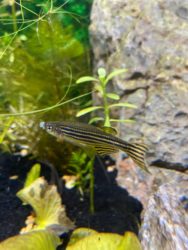
Unlike other species, these fish do not confine themselves to a single region of the aquarium. While they like the middle and upper ranges of the water column, they are prepared to wander practically wherever!
Consequently, many aquarists choose to maintain them as dither fish in their aquariums.
Is Zebra Danio A Loner Or Societal?
Zebra Danios are laid-back and cheerful animals. They’re pretty lively and will spend their days darting around the tank, which is hilarious.
Zebra Danio Tank Mates
Having more Zebra Danios in the aquarium is ideal for this species. These are shoaling fish, which means they require the companionship of other fish to stay healthy. Zebra Danios become shells of their former selves when they are left alone for lengthy periods.
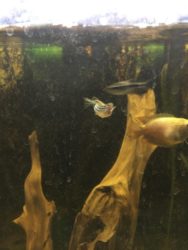
They acquire sentiments of shyness and nervousness.
As a consequence of their sickness susceptibility and stress, the social part of Zebra Danio care is essential to ensure a safe environment.
Ideal Zebra Danio Tank Mates
Aside from other Zebra Danios, these fish get along with a broad range of different species. They’re kind and can cohabit happily with other fish of a similar attitude. It is preferable to keep away from any aggressive fish or species that are considerably larger than them.
Here are some lovely Zebra Danio tank mates to consider:
- Honey Gourami
- Ember Tetra
- Corydoras
- Celestial Pearl Danio
- Emerald Pufferfish
- Neon Tetra
- Flying Barb
- Peaceful Freshwater Catfish
- Most Loaches
Bad Tank Mates for Zebra Danio
Zebra danios are suitable with vivid, peaceful fish of a similar size. Don’t maintain zebra danios with slow-swimming, long-finned fish because zebra danios are fin-nippers. Avoid big, predatory tank mates as these fish see zebra danios as food.
Breeding Zebra Danio
The females of the Zebra Danio are generally brighter in color while the males are better streamlined and thin in shape. This makes identification of the sexes quite easy. Breeding of the fish is quite easy and in some instances they may just breed in the tank alone with even your involvement.
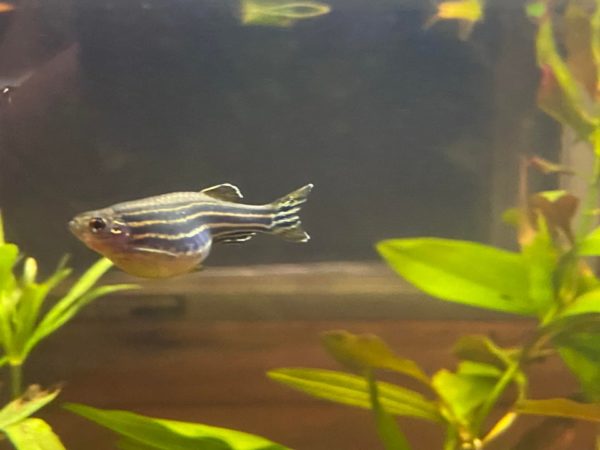
You should start with Zebra Danios if you are new to the fish-keeping hobby and want to experiment with breeding. They are one of the simplest fish to breed, making fantastic pets.
They are relatively easy to breed and are a fantastic option for new breeders hoping to acquire some experience.
However, as with other fishes, there are specific procedures that you must follow, as well as create special situations before your Zebra Danios may happily breed.
Two different sexes of the fish are known to form a breeding pair with the male known to remain attached to a particular female! With good and favorable conditions for mating, the female fish will release her eggs in the water and the male will fertilize them. Once fertilized, he eggs will then sink to lower parts of the aquarium where they will hatch after approximately seven days.
Zebra Danio Breeding Level
Easy
Zebra Danio Sexual Dimorphism?
Differences between men and females are minimal. Males tend to be smaller and slimmer, and they boast a more streamlined torpedo design. Females, however, are a bit plumper and rounder.
Zebra Danio Common Diseases And Their Treatment
Ich
Ich is a parasitic skin disease caused by the parasite Ichthyophthirius multifiliis that affects the upper respiratory tract. White spots on the fish’s body, lethargy, and flashing are all signs of Ich. The fish rubs its body against rough surfaces, which causes the white spots to appear.
If you find indications of Ich, isolate the infected fish and raise the water temperature to 77°F to shorten the parasite’s life cycle and reduce the likelihood of infection.
Mycobacteriosis is caused by bacteria that are not mobile. You may notice various symptoms in your fish as it spreads swiftly around the tank. Zebra Danios are prone to ulcers, skin irritation over the body, and even fin loss in adulthood.
Mycobacteriosis, on the other hand, is a complicated infection to cure. The most effective course of action is to remove diseased fish from the aquarium and change the water often to eliminate the disease. Even under the best of circumstances, many fish do not have a favorable outlook.
Nematode infections are also a prevalent occurrence. Because of the physical alterations caused by these parasites, the fish appears darker in color. Not only that, but most fish will get sluggish and begin to lose weight due to the stress.
Facts About Zebra Danio
- The capacity of zebrafish to rebuild their heart muscle is astonishing. They may reconstruct a section of their heart in a matter of weeks if a portion of it is removed.
- Zebrafish males and females are fantastic pets to maintain for novices and are favorites among fish-keeping enthusiasts due to their small size.
- Zebra danios are a gregarious species that thrive in the presence of others.
- If you don’t maintain your zebra danio fish in a school, they’ll get stressed and aggressive against other fish in the aquarium or tank.
- The Zebra danios are one of the few organisms that have been to the furthest regions of space.
Is Zebra Danio Right For You?
You should purchase a zebra danio if you have adequate room for homing at least five to six lively fishes, and your tank doesn’t include long-finned or slow-moving fish. Zebra danios are energetic, fascinating fish that provide a splash of color to the aquarium.
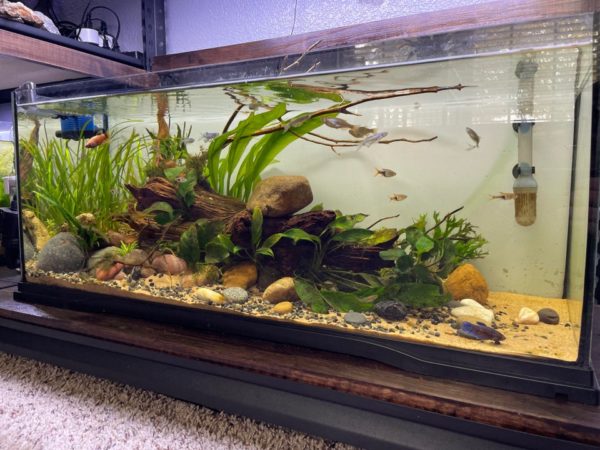
Don’t introduce zebra danios to a tank containing predatory fish or to tiny tanks that don’t give appropriate swimming room for the zebra danios.
FAQs
What Distinguishes Zebra Danios From Other Types Of Danios?
The zebra danios are little fishes with a long, tube-like body of 0.9 inches (2.5 cm). Their heads are dorsally compressed, with their eyes in the center. Zebrafish have an upward-facing mouth, giving them a characteristic fish shape.
How Do They Communicate With One Other?
Zebra danios’ vision and motion sensitivity help them anticipate environmental changes and escape predators. Their lateral line system detects the pressure variations in the water surrounding them (sense organs).
When It Comes To Swimming, How Quickly Can A Zebra Danio Go?
They have a lot of energy and need to burn it off by swimming swiftly. Zebra danios may live in both fast- and slow-moving streams.
What Do You Call A Baby Zebra Danio?
The zebra danio’s eggs are relatively small. They refer to a newly hatched fish as a fry until it matures. Shrimp is an excellent approach to guarantee the nutrition they need to grow into adults.
Conclusion
The zebra danio is a freshwater fish belonging to the danio group and the Cyprinidae family. The bodies of zebra danios are slender, with horizontal black and white zebra-like stripes running down their bodies.
They are popular among aquarists due to their calm and social temperament; however, they may turn aggressive if maintained in a crowded tank.
As you can see, taking care of Zebra Danios is a cakewalk. This freshwater species should prosper as long as you supply them with appropriate attention and keep a correctly constructed tank environment.
No related posts.
